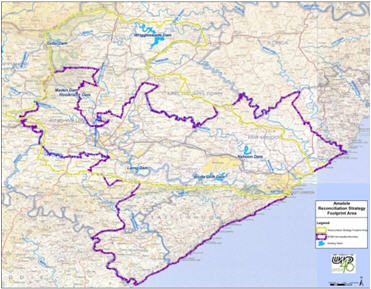|
The Amatole Water Supply System (AWSS) primarily provides water to the communities within the Buffalo City Metropolitan Municipality area, but also provides water to certain communities in the Amahlathi and Ngqushwa Local Municipality areas. Irrigators along the upper and middle reaches of the Kubusi River also receive water from the system. The major water user from the AWSS is however the urban sector within the Buffalo City Metropolitan Municipality (BCMM).
The main towns in the study area include East London/Mdantsane, King Williams Town and Bhisho located within BCMM, and Stutterheim located within the Amahlati Local Municipality.

The main storage dams of the AWSS are the Gubu, Wriggleswade, Rooikrants, Laing and Nahoon dams (owned by the Department of Water and Sanitation (DWS) and operated by Amatola Water (AW)) and the Bridledrift and Maden Dams (owned and operated by the BCMM). The water storage in the system is evaluated towards the end of the wet season (no later than April 1st), to assess whether or not supplies need to be restricted for the following year, to ensure that sufficient water remains for the more essential users, were a drought to occur. The dams are operated as an integrated system to minimise spillage and maximise storage during drought months.
Operational challenges include the need for close co-operation between DWS, BCMM and AW and the operation of the Wriggleswade transfer system that provides the means of transferring water from the Kubusi River to the Buffalo River
Population, Economy and Water Requirements
The population and population growth rates in the study area are difficult to determine with any degree of certainty, given the complexity of the migration patterns and the sensitivity of these to the relative economies of surrounding regions and cities, coupled with the impact of HIV/Aids. Indications are however that the population of BCMM may have grown at a higher rate (1.46% pa) than the national average between 2001 and 2008 (1.25% pa to 1.06% pa).
Many of the primary and secondary sectors of the economy in the region have been in decline for some time, with a resultant change in employment patterns. There is now a significant dependence of the labour force on the service sector for employment (mostly employed in government services), with the highest rate of absorption of labour (24%) in this sector. This is followed by the wholesale/retail trade (16%) and the manufacturing sector (15%).
The economy of East London is however expected to grow going forward, due to its close location to the port and large labour force. Initiatives such as the West Bank Industrial Development Zone, which is premised on the locational advantages of East London and its harbour, are currently being planned as a means to provide investment to the area.
Various future water requirement scenarios have been developed based on current and predicted future population data from various sources, coupled with predictions of progressively increasing levels of water services being provided, as well as projected industrial and agricultural water requirements. The average growth in water requirement for the area under a ‘high growth’ scenario has been estimated at 1.3%pa and -0.5%pa under a ‘low growth’ scenario (over the 3 year planning horizon).
|